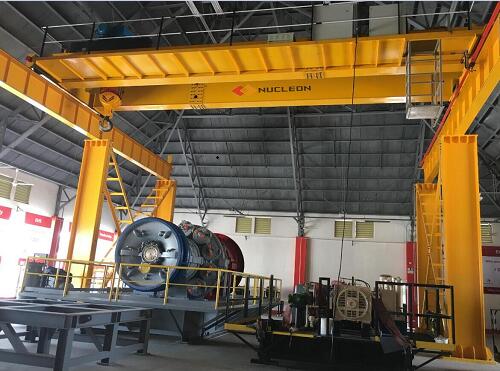Double Girder Electric Bridge Crane
Double Girder Electric Bridge Crane
The electric double-girder bridge crane is a highly efficient and heavy-duty lifting device, widely used in factories, warehouses, ports, steel mills and other places where heavy materials need to be frequently lifted. Its structure is stable and has strong load-bearing capacity, making it suitable for continuous operation environments at high working levels (A6 to A8).

- Main structure and composition
Main beams: Two box or truss beams, providing higher rigidity and load-bearing capacity.
End beam: Connects the main beam and supports the crane to run along the track.
Lifting mechanism: Equipped with large-tonnage electric hoists or winches (such as wire rope electric hoists or chain hoists).
The running mechanism: Both the large car (moving longitudinally along the track) and the small car (moving laterally on the main beam) are driven by motors.
Electrical control system: variable frequency control, PLC or traditional relay control, with remote control or cab operation options available.
Safety devices: overload limiter, limit switch, anti-collision device, emergency brake, etc.
- Main types
General-purpose double-girder bridge crane: Standard design, suitable for general industrial environments (5 to 550 tons).
Metallurgical special crane: High-temperature resistant, anti-magnetic, explosion-proof, suitable for the steel smelting industry.
Grab/Electromagnetic crane: Equipped with a grab or electromagnetic suction cup, it is used for handling bulk materials or magnetic materials. Low headroom lifting standard: Optimized main beam height, suitable for occasions where the height of the factory building is limited.
- Core features
High load-bearing capacity: The double-beam structure is more stable than the single-beam one and is suitable for large tonnages (up to several hundred tons).
Smooth operation: Variable frequency speed regulation technology reduces the impact during start-up and shutdown.
Long service life: Made of high-quality steel, it has strong fatigue resistance and is suitable for high-intensity operations.
Multiple control methods: Supports cab, ground handle, and wireless remote control operation.
- Typical application scenarios
Heavy industry: steel mills, shipyards, mechanical manufacturing workshops. Logistics and warehousing: Large warehouses, container terminals. Energy industry: Installation and maintenance of power plant and hydropower station equipment. Metallurgical industry: Steelmaking, casting, and steel rolling production lines.
